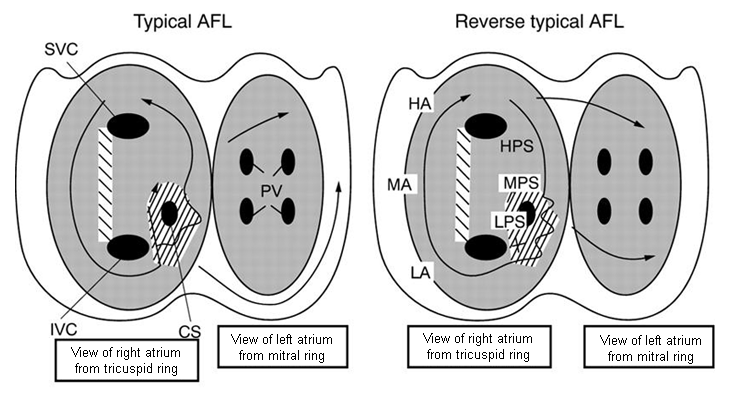Etiology
Atrial flutter generally results from structural or functional conduction abnormalities of the atria. Structural abnormalities include atrial dilation due to a number of processes (see Risk Factors); incisional scars from prior atrial surgery, particularly for congenital heart disease; prior atrial ablation sites; and idiopathic fibrosis within the atrium. In addition, it can be precipitated by toxic and metabolic conditions such as thyrotoxicosis, alcoholism, or pericarditis. Patients taking antiarrhythmics for chronic suppression of atrial fibrillation may convert to atrial flutter, noted most commonly with Vaughan Williams class Ic drugs (flecainide and propafenone) and with class Ia (disopyramide, procainamide, quinidine) and amiodarone.[7][8]
Other medications that can cause or exacerbate atrial flutter and atrial fibrillation include sympathomimetics, stimulants, immune modulators, and antineoplastic agents.[9]
Occasionally, atrial flutter can be congenital.[10]
Pathophysiology
The typical form of atrial flutter is a prototypic macroreentrant arrhythmia, in which the reentrant wavefront travels up the interatrial septum and down the right atrial free wall ("typical" form) or vice versa ("reverse typical" form). The lateral anatomic boundaries are critical to the development and maintenance of the circuit. One of these boundaries is the tricuspid valve annulus and is fixed or anatomic. The other is generally a functional line of block between the venae cavae.[11] Atypical flutters are seen when the cavotricuspid isthmus is not part of the circuit, and are characterized by a continuously undulating pattern by ECG that does not fit strict criteria for the typical and reverse typical forms of atrial flutter. This is a limitation in the mechanistic/anatomic classification scheme, as the exact mechanism can be determined only by electrophysiologic mapping studies and not from the ECG alone. Clinical presentations and electrophysiologic features of atypical atrial flutter and other types of atrial tachycardias can overlap.[2][Figure caption and citation for the preceding image starts]: Left panel: atrial activation in typical atrial flutter (AFL). Right panel: activation in reverse typical AFL. The atria are represented schematically in a left anterior oblique view, from the tricuspid (left) and mitral rings. The endocardium is shaded and the openings of the superior (SVC) and inferior vena cava (IVC), coronary sinus (CS), and pulmonary veins (PV) are shown. The direction of activation is shown by arrows. Dashed areas mark approximate location of zones of slow conduction and block. Lettering on the right-hand panel marks the low (LPS), mid (MPS), and high (HPS) posteroseptal wall, respectivelyFrom: Waldo AL. Heart. 2000 Aug;84(2):227-32; used with permission [Citation ends].
Classification
American College of Cardiology/American Heart Association/Heart Rhythm Society classification of atrial flutter/atrial tachycardias[4]
Atrial flutter is a macroreentrant atrial tachycardia with constant P wave/flutter morphology with a rate usually >250 bpm. It is distinguishable from focal atrial tachycardia, which has discrete P waves with an intervening isoelectric segment. Focal atrial tachycardia is caused mechanistically by micro-reentry or increased automaticity and generally has atrial rates in the range of 100-250 bpm.
Cavotricuspid isthmus dependent (typical atrial flutter):
Counterclockwise atrial flutter with ECG flutter waves characterized by:
Negative deflection in leads II, III, aVF
Positive deflection in lead V1.
Clockwise atrial flutter (reverse typical atrial flutter) with ECG flutter waves characterized by:
Positive deflection in leads II, III, aVF
Negative deflection in lead V1.
Non cavotricuspid isthmus dependent (atypical atrial flutter):
Re-entry that does not depend upon conduction through the cavotricuspid isthmus
Circuit is typically defined by atrial scars due to prior heart surgery, ablations, or idiopathic causes
Location determines ablation approach and risks
Multiple sites of re-entry may be present
Can occur in both the left and right atria.
Use of this content is subject to our disclaimer